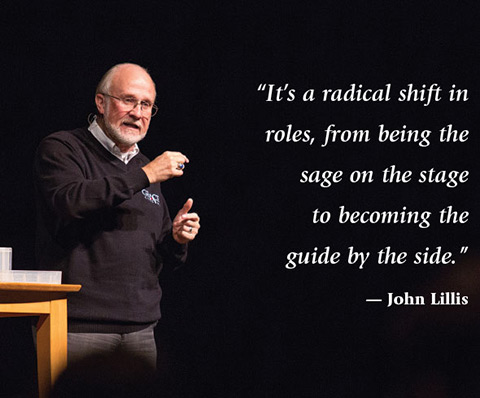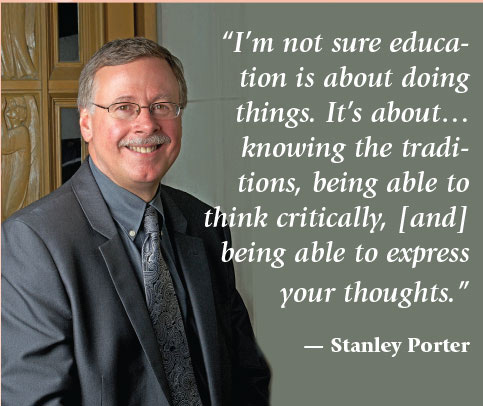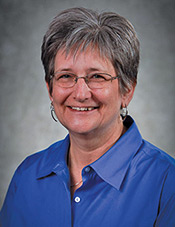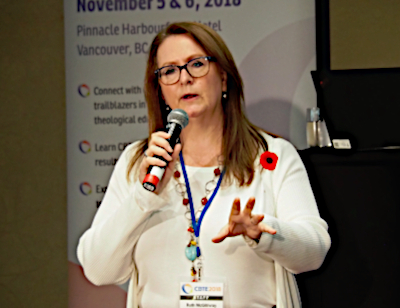
“We were the guinea pigs,” says Wes Parker. Parker and his fellow students who enrolled in Northwest Baptist Seminary’s “Immerse” M.Div. program knew they were part of something very experimental. In 2012, Northwest launched the first ATS-accredited, direct-assessment, competency-based theological education (CBTE) program leading to a master of divinity degree.
“We reverse-engineered the seminary experience,” says Kenton Anderson, president of the seminary, which is located on the campus of Trinity Western University in British Columbia. Starting with the end in mind, Northwest redesigned their flagship divinity degree by first working with their denomination to identify the skills, knowledge, and attitudes needed to be most effective in ministry. The Immerse program was designed to help students develop those skills, gain that knowledge, and foster those attitudes.
“It was a radical change for us,” says Anderson. “We didn’t fully understand what we were really asking of ourselves when we began, but we took a plunge and started pulling on that thread and seeing where it would lead us.” Wes Parker and his fellow students had no idea what to expect because at first, the seminary leaders didn’t know either. “That was attractive to me,” says Parker. “I had done a traditional theological education with my undergrad. I had experience with both.” He found that he could thrive under the new program.
“Competency-based education” in a nutshell
Competency-based education (CBE) is found most often in hands-on fields like computer technology, business administration, and some medical fields. CBE requires mastery of multiple “competencies” spread across disciplines. Those competencies may include skills, knowledge, attitudes, or a combination of these. For example, at Western Governors University, a flagship school employing CBE, the master of science in nursing leadership requires competencies like these:
- The graduate demonstrates expertise in nurse leader roles to improve operational performance needed to improve quality and safety in healthcare organizations.
- The graduate uses data and analytics to advance the operational performance of a healthcare organization.
- The graduate evaluates the responsibility and accountability of nursing management in the operations of complex healthcare organizations.
- The graduate demonstrates the ability to effectively manage human resources to promote a professional environment conducive to skilled and safe patient care.
A complete description of the program, including all of the required competencies, can be found at bit.ly/WGU-nursing.
At Western Governors, a single course might provide an opportunity for a student to master a single competency, but most courses cover multiple competencies. Instructors (subject-matter experts who hold doctorates) teach courses, but program mentors are the more hands-on guides for students, helping them to review required competencies, set goals, and select courses of study.
T is for “theological”: CBE becomes CBTE
In nursing, as in many fields outside of theological education, the adoption of competency-based learning has come from a concern that traditional education has failed adult learners by not preparing them for the real world. That feeling reverberates with CBTE supporters as well, with the conviction that traditional seminary programs are not preparing graduates adequately for church leadership and pastoral responsibilities.
In CBTE programs, as in CBE programs more generally, the competencies themselves vary from school to school. But in CBTE, students must always be immersed completely in a ministry setting, which provides both spiritual nurturing and practical experience. Most often this is a large congregation where the pastor serves as the student’s ministry mentor.
Some examples of competencies required in theological education, borrowed from the 18 competencies in the “Deploy” M.Div. program at Grace Theological Seminary in Indiana, include: “Thinking Critically in Ministry,” “Research and Writing,” “Practicing Biblical Hermeneutics,” “Utilizing Biblical Languages,” “Embracing Cultural Diversity,” and “Initiating Transformational Change.” Achieving mastery of each competency can be a multiyear process.
The validity of assessment (that is, determining whether a student has actually achieved mastery of a competency) is of profound importance. In most CBTE programs, a team of mentors determines whether a student has mastered a competency. For example, at Grace, a student’s “ministry mentor,” “formation mentor,” and “faculty instructor” must agree when a student has mastered a competency. Their assessment may be based on written work, hands-on ministry in the parish setting, testing, or a combination of these.
Is CBTE gaining ground?
In 2018, In Trust set out to determine how much traction CBTE has gained in the seminary world. What questions are seminary stakeholders asking about CBTE? How was it pushing out the edges of traditional seminaries? We surveyed representatives of the In Trust Center’s member schools and then interviewed 19 leaders from both American and Canadian seminaries.
In Trust’s snapshot reveals a community that is divided. Like most disruptive movements, those who love it, love it a lot. “As an educator, when I first heard of this I thought, ‘This is what I’ve been waiting for my whole life. This is it!’” says John Lillis, provost at Grace, who may be one of North America’s most ebullient champions of CBTE. In the informal In Trust survey of 26 people from schools that have adopted CBTE, we found that almost all said that they were motivated to adopt CBTE by a desire to provide a higher quality education. Fewer than 20 percent said that the need to decrease expenses motivated them.
But those who don’t like CBTE, really don’t. Those voices articulated the three most common objections to competency based theological education:
- It’s not academically rigorous enough.
- It’s not spiritually formative enough.
- Students need to be in the traditional classroom in order to be best prepared to be a pastor.
In the informal In Trust survey of 102 people from schools that have not adopted CBTE, more than 20 percent said that they have looked into CBTE, but they’ve decided that it is not right for them.
 |
| Grace College and Seminary |
In the middle of the debate, though, is a sizeable group of what might be called “cautious explorers”— more than 30 percent of the respondents of the In Trust survey of people from schools that have not adopted CBTE. They are largely intrigued by CBTE, seeing it as a potential complement to innovations they are already experimenting with, and not wanting to be left behind as theological education changes.
Within individual schools there is a similar spectrum of opinions — some big fans, some resolute naysayers, and many in the middle. “There are some people who are dug in and won’t change their minds,” says Craig Williford, president of Multnomah University in Oregon. “The majority of us are in the middle, undecided and kind of looming back and forth between the positives and the negatives, and the barriers and the challenges.” These explorers are waiting to see how the pioneering schools will fare. They are open to contemplating how their own school might adapt some of the best of what competency-based programs might have to offer into their own context.
Catalysts and obstacles on the road to implementation
In Trust was interested in finding out how schools that have adopted CBTE built collective goodwill toward this new model of education and how they overcame objections and obstacles. During in-depth conversations with administrators at 11 schools, some key themes emerged:
1. The question of financial pressure
To be sure, the push in some denominations for seminaries to prepare students more effectively has been a key motivation for the adoption of CBTE in some schools. However, other schools are considering CBTE because they are in a do-or-die moment. “The wolf was at the door,” says Lillis. Providing education in traditional ways was not a real option at his school, because it was no longer financially viable.
Greg Henson, the president of Sioux Falls Seminary in South Dakota, says something similar. His faculty was willing to try CBTE because they knew that the seminary’s financial situation was serious. There was “some sense of urgency,” he says.
This urgency means that at pioneering CBTE schools, pushback has been minimal. “We weren’t in dire straits,” says Kenton Anderson, president of Northwest, “but like a lot of schools, we were seriously concerned about the future.” Anderson says they were trying to look ahead and see where things were going. “We decided to be proactive and rearrange ourselves in a way that will allow us to be effective long into the future.”
Other seminaries under financial pressure, though, are still reluctant to make dramatic programmatic shifts. For example, full-scale CBTE adoption is probably not on the horizon at The General Theological Seminary in New York. “I’m not particularly anxious about the wolf being at the door, because we have the Lamb in the building,” says Michael DeLashmutt, vice president and dean of academic affairs. DeLashmutt has been part of a school closure before, so he’s aware of the pains caused by shutting down a beloved institution. But he has a theological and spiritual commitment not to be anxious.
DeLashmutt is intrigued by the idea of a hybrid approach, but if his seminary adopts some form of CBTE it won’t be because of finances. “If I actually believe that God is somehow involved in this work, even if it fails — God is still in it,” he says.
2. The question of the nature of theological education
“One of my big concerns is when you put ‘competency-based’ near the word ‘education,’” says Stanley Porter, president of McMaster Divinity College in Ontario. “I don’t think they go together.”
Porter is an advocate of the “humanities” approach to theological education. “I’m not sure that education is about doing things,” he says. “It’s about becoming an educated person, knowing the traditions, being able to think critically, being able to express your thoughts.”
Most theological educators agree that theological education is also about formation, and where formation happens best is a key question that lies at the heart of the CBTE discussions.
|

McMaster Divinity College
|
“I’m afraid that if you work on the training model and the tasks change, graduates won’t be adequately equipped to deal with changing situations,” says Porter. “I’d prefer to have people with a broader educational background so they can think about things — so that they have a base to rely on.”
At Sioux Falls, Henson agrees that formation is a critical factor in discussions surrounding CBTE. He says that if you just do competency-based education — without the word “theological” — you miss the formation piece. “At its core, CBTE is a journey of discipleship. You should be different when you are done.”
Stephen Graham, senior director of programs and services at the Association of Theological Schools (ATS), stresses the importance of ensuring that effective formation continues with new educational models. “Usually effective formation has four dimensions: intellectual, pastoral, human, and spiritual,” he says. “All four need to be robust and present and assessed. Competency-based education has to demonstrate those, just like any other program.”
Proponents of CBTE argue that formation happens best in the spiritual communities where students already live and work, with mentors who are fully engaged in their lives. Advocates of traditional theological education counter that formation happens best in seminary classrooms, cafeterias, and chapels. They say that the relationships among students, and between students and faculty, are critical aspects of formation that take place during that rare time set apart for a student to concentrate on spiritual and  intellectual pursuits.
intellectual pursuits.
3. The question of faculty disagreement
“This is an exceedingly difficult journey for faculty, and they are not there yet,” says David Williams, president of Taylor Seminary in Alberta. Taylor is living in the tension of a multiyear transition toward implementation of CBTE. They’re partnering with Sioux Falls Seminary, which is a sister institution within the North American Baptist Conference. “I suspect in five years we will be pretty thoroughly shaped around what Sioux Falls calls the ‘Kairos’ model. We will be a contextual, competency-based, student-driven institution,” says Williams. But he cautions that the seminary faculty have been formed under the traditional model, in which courses are offered at particular times for particular numbers of credit hours. It’s not easy for some faculty to make the transition.
Jeanne Hoeft is vice president of academic affairs at Saint Paul School of Theology in Kansas, which is considering a move toward CBTE. “There was a lot of initial resistance,” she says. Hoeft reports that faculty resistance has centered on vocational formation and the creation of identity among students. They wonder how those aspects of theological education will take shape in CBTE.
Western Seminary in Oregon is another school in the “cautious explorer” category, testing the CBTE waters. “There are different individuals who are really excited about this, and some that aren’t excited,” says Randy Roberts, the school’s president. He says that curricula and pedagogical practices have traditionally been the domain of the faculty. So when an administrator is pushing a CBTE model, it can seem like impinging on faculty prerogatives.

Even at Northwest, a pioneer in CBTE, faculty were hesitant at first, explains Rob Brynjolfson, director of global initiatives. “They had a hard time getting their heads around someone learning without going to class. I’ve since discovered that what really brought them around was a passion for pastoral ministry. They saw themselves as training pastors, so they weren’t just preparing people for careers in academia. When they started to listen to the rationale, it made sense to them. There was a negotiated peace — that there would still be instructional components in the program. The faculty weren’t just turned into mentors; they could still teach.”
The jury is still out
How graduates of the programs fare in their ministry will surely be clearer in years to come. Wes Parker graduated in 2017 from Northwest’s Immerse M.Div. program. He was already in full-time pastoral ministry, already serving the church where he performed most of his competency-based learning and formation. His comment on his seminary preparation is positive. The program was “almost like a medical residency,” he says. “You’re doing the job as you’re learning it with the safeguard of the mentor team — who make sure you don’t kill anyone on the table.”
First CBTE conference was an opportunity to network and learn more
In November 2018, Northwest Baptist Seminary hosted “CBTE2018,” billed as the first international conference on competency-based theological education. The program included keynote addresses by Charla Long, executive director of the Competency-Based Education Network, and two presidents of schools that have been pioneers in CBTE: Kenton Anderson (pictured left, holding microphone), president of Northwest Baptist Seminary, and Greg Henson, president of Sioux Falls Seminary.
The In Trust Center for Theological Schools made an appearance as well. Amy Kardash, the Center’s president, and Jay Blossom, vice president for communication, presented a workshop on “Moving Ahead Without Leaving Key Players Behind,” in which they presented findings from the same surveys and interviews on which this article is based.
A free online course on CBTE has been created to share the resources from the conference. To learn more, visit bit.ly/CBTE-2018. (Note: You will need to create a free account.)
 |
Ruth McGillivray, director of competency-based education at Northwest Baptist Seminary, was the coordinator of CBTE2018.
Photos courtesy Northwest Baptist Seminary |
Articles and resources on competency-based theological education
In Trust articles
♦ “No More Courses” (New Year 2016): www.intrust.org/No-more-courses
♦ “Credit for What You Know and Do, Not for Time in Class” (Summer 2016): www.intrust.org/Credit
♦ “Competency-Based Education Has a History” (New Year 2017): www.intrust.org/CBE-history
Report from the Association of Theological Schools
♦ ATS Educational Models and Practices peer group report on competency-based education:
bit.ly/CBE-peer-group-report
Christian Century article
♦ “Startup Seminaries” (February 1, 2017): www.christiancentury.org/article/startup-seminaries
For more resources on CBTE, email resources@intrust.org.